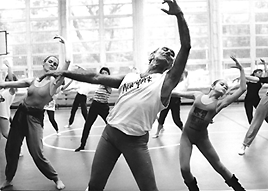- Jazz is indigenous to America, and began with the African slaves, who secretly danced to cling to their traditions and culture, but were not allowed to by the Slave Act of 1740.
- The Africans brought their rhythms to America - earthy; low, knees bent, pulsating body movements emphasized by body isolations and hand-clapping.
- By the 1920s, as the jazz movement was sweeping from New Orleans to the rest of the country, jazz and tap dance gained popularity. The two dance forms were often the same - with tap being referred to jazz.
- Until the mid 1950s, the term "jazz dance" often referred to tap dance, because tap dancing (set to jazz music) was the main performance dance of the era. During the later jazz age, popular forms of jazz dance were the Cakewalk, Black Bottom, Charleston, Jitterbug, Boogie Woogie, Swing dancing and the related Lindy Hop. (dancelessons.net)
- With World War II came a stop to the popularity of jazz social dancing, and jazz dance as a professional dance, performed by dancers who were trained in ballet and modern, came to life.
- During this time (the 1940s), Jack Cole, known as the "Father of Jazz Dance," began working in Hollywood training actors and actresses in jazz dance for movies.
- Jack Cole is credited with developing the ballet-based movements and theatrical expression which are the touchstones of contemporary jazz dancing. (Dance Tutors)
- Cole's style was seen in his musicals such as "A Funny Thing Happened on the Way to the Forum," "There's No Business Like Show Business," and "Man of La Mancha." It was also seen in his movies, including, "Gentlemen Prefer Blondes" and "There’s No Business Like Show Business."
- By the 1950s, Jerome Robbins, who was greatly influenced by Cole, became famous for his jazz choreography with the Broadway production of "West Side Story."
- In the 1960s, jazz greats Luigi and Gus Giordano gained fame - Luigi's for his holistic, lyrical jazz style that helped him recover from a serious auto accident.
- Giordano's style was known for isolation movements, emphasizing the head and torso and creating an uplifted look of elegance. Yoga is incorporated into Giordano’s technique as a means of relaxation. (University of Houston - Jacqueline Nallet).
- Later, in the 1970s, Bob Fosse appeared on the scene dancing and choreographing Broadway plays such as "Dancin" and a reproduction of "Chicago."
- Fosse's style was distinct; it was highly creative and often included bizarre movements; it was slick, erotic and intense. He was a one man jazz phenomenon whose style continued to make its mark on the Broadway stage and in Hollywood throughout the 1980s. (University of Houston - Jacqueline Nallet)
Saturday, September 18, 2010
Some Jazz Dance History
Most of us probably think history is pretty boring, like learning dates and wars and names. But, as discussed in the previous blog, true jazz dance is dying in part due to the fact that we don't know it's history and origins. So, I've pulled the must-know jazz history facts, to make it a little less boring, but also to make sure we all know more about this incredible dance form!
Labels:
Bob Fosse,
Gus Giordano,
Jack Cole,
Jazz,
Jazz History,
Jerome Robbins,
Luigi
Subscribe to:
Post Comments (Atom)





Jazz dancing has a very unique history and has been influenced by many other dance styles and techniques. Like jazz music, its roots can be found in African and slave traditions. It then took inspiration from tap, Minstrel shows, vaudeville, swing and Broadway. The result is that the styles associated with jazz dancing constantly change.
ReplyDeleteMonir Sider
You know your jazz facts! Glad there are dancers out there who know their stuff :).
ReplyDeleteAfrican-American dance elements, which the slaves imported to the USA, are still part of the Jazz Dance, which has become its own art and dance form has evolved.
ReplyDelete